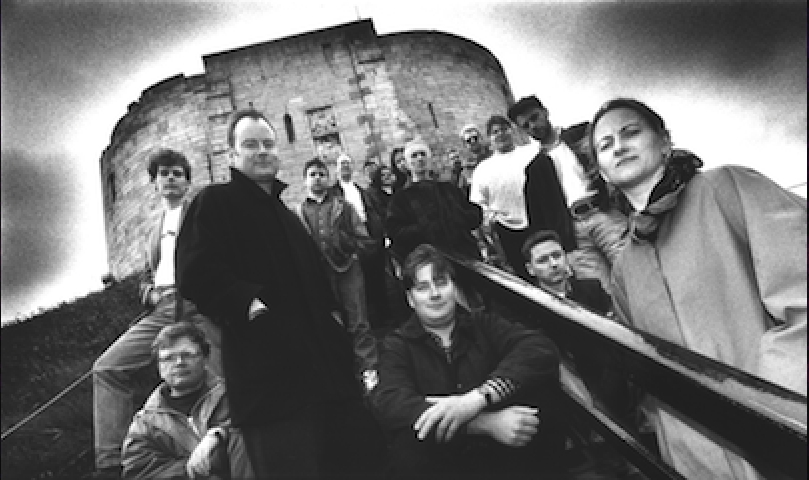Revolution Software 8/8
Why 8/8? Because Revolution Software, is one of the few teams in videogames’ history that hardly had missed a trick. Actually, in my opinion, they haven’t at all.
In the early ‘90s, two Activision and two Bytron (a company that developed aeronautic software) employees, joined together to seek fame and glory in adventure games’ development. We’re talking about Charles Cecil and Norin Camody from Activision and Tony Warriner and David Skyes from Bytron. We may say that the actual founder of the team was Cecil’s mother, since she donated 10.000£ to fund her son’s project. Cecil and Warriner met each other years before, when they were both working at Artic Computing, but the company went bankrupt and, after a short period at Paragon Programming (founded by the enterprising Cecil), their paths splitted when Cecil was recruited by US Gold.
These guys left an incredible job to make their way in the game industry, trying to shoulder aside other people such as Sierra Entertainment, LucasFilm Games (then LucasArts). Something really foolish, considering that they hadn’t a publisher that could push them into the market. Yet, one day, the phone rang. It was Sean Brennan, Mirrorsoft deputy Managing Director, who invited Cecil to dinner and guaranteed him full support from his company for his new development team, as soon as they could provide a convincing concept for a videogame.
Cecil mom’s money began to prove useful, now, since it made possible to Warriner to develop an engine capable to automatically and autonomously manage all the NPCs actions and movements inside a game. This engine went under the name of Virtual Theatre and, along with its development, also began the early development stages for a concept to show.
Once ready, the concept’s prototype had to be showed, so the four went to Mirrorsoft’s offices to conquer the publishers. It could have been a one-way journey, since, during the trip, they had left their car unattended for few minutes, enough for a thief to enter the vehicle and steal their radio without noticing the PC (which contained the whole game concept and its presentation) on the backseat. After this lucky shot, the four reached and conquered Mirrorsoft as they commissioned the development of the game, giving 20.000£ as a funding. From that very moment, Revolution Software was officially born!
Their first game was Lure of The Temptress, published in 1992 on Atari ST, MS-DOS and Amiga thanks to the help from Virgin Interactive, which took the place of an almost-bankrupted Mirrorsoft (which was going to be acquired by Acclaim). The title was not very successful, but stayed on the market for quite a while and, as you can see in the following video (if you fear the spoiler for a 20 years old title, well, just watch half of it and don’t troll into the comments!), it provided the basis for THE Revolution Software masterpiece:
[HTML1]
This game let Revolution Software team move to York and begin to work at the title that put them under the spotlight of the videogame scene: Beneath a Steel Sky. For the game’s development, they teamed up with the comic artist Dave Gibbons (Watchmen? Anyone?). The title has many cyberpunk elements along with some comic ones that were very helpful in pushing the title into fame. As a result, the game was a great success, both on the critic and the sales’ side. It went out in 1994 for MS-DOS, Amiga and Windows (I’ll say something more that you may actually like!)
Full of satisfaction (and, maybe, money too), Cecil, Carmodin and Brennan (at the time, already member of Virgin Interactive) went to dine together. Enjoying a couple of glasses of wine, their chit-chat focused about the myth surrounding the Knights Templar and, as it happens for great ideas, they realized that that specific history subject could make a great background for a game, for an adventure game. In a totally nerd way, after some wine and a dinner with a woman, all that happened that night… Was the grounding of the former idea of what was going to become the Revolution Software masterpiece.
Their expectations for their new title were high and, though Beneath a Steel Sky was a success, they needed fresh talents to continue facing their competitors. So Cecil persuaded Eoghan Cahil and Neil Breen – both from Don Bluth Studios – to join Revolution Software and work at the background art (hand drawn and then colored with Photoshop). The concept and development of the main characters was given to the genius of Mike Burgess (designer and animator, tragically gone shortly after the end of development not even 30 years old). The music composition was left to Barrington Pheloung, who met Cecil years before, during a Cricket game.
Thus, Revolution Software scored its best shot, developing that masterpiece that goes under the name of Baphomets Fluch, or Les Chevaliers de Baphomet, or La leyenda de los Templarios or Circle of Blood. Each country had a different title for the same game, but it will be remembered with its original English title: Broken Sword.
It was 1996 and Broken Sword: The Shadow of the Templars went out on PC, Mac and Playstation. It was a great success: the critics described it as a masterpiece and sales reached unimaginable peaks. The charming atmosphere, along with strong noir tints, melt with a subtle hilarity in dialogs and events, without letting the title lose its former seriousness. Pure class.
The title was so much a success that the team immediately began working on its sequel, with the same staff behind the first one. So, in 1997, Broken’s Sword II: The Smoking Mirror was released. Another great success, even if the noir tints were far less strong, both because of the plot (which involves magic and witchcraft) and the exotic setting. Anyway it was a great game with great puzzles.
Four years passed. Technology had made giant steps. In the year 2000, the team began writing the first few lines for the third instalment of Broken Sword series, but Ubisoft came along in the meantime and commissioned to the team the development of The Road to El Dorado, a game that used the license from the homonymous animated film . The title (That I really loved!, Ed. Er’Pupo) went out on PC and Playstation and was completely in 3D, even if was still an adventure game with dialogs and puzzles to solve through the two main characters cooperation. Even here a strong sense of humour is easily noticeable and the sound effects seem to come directly from Broken Sword.
[HTML2]
Still in 2000, Sony called Ubisoft, which then called Revolution Software to develop another game. This time they wanted something that could go beyond the adventure games of the time. Thus the team developed In Cold Blood, released on PC and Playstation. The game, as said, walked out the common adventure games’ rules, adding stealth action components along with gunfights, yet it still keeps many “classic” elements, such as puzzles and dialogs. This title was developed in 3D as well (And I really loved this one too!, Ed. Er’Pupo)
[HTML3]
Both titles were not so successful, speaking of sales and critics, even if they were two decent products. So, Revolution Software, announced to be working on Good Cop, Bad Cop, an action game with moral choices with aftermath on the plot progress. The title was in development for Playstation 2, PC and Xbox with a release date in 2003, but due to development issues the game was at first postponed to 2004, then canceled.
Months passed and the will to release the third adventure of George Stobbart was growing. Finally, THQ came to fund the project. The former idea was to follow the 2D classic style, but the publisher refused it, preferring a 3D approach. Cecil really didn’t like the publisher’s decision, which brought him to say that “adventure games are dead”, but the will to develop another chapter for the series (since, at the very beginning, the idea was to create a trilogy) that they eventually bent at the publisher’s will. The team involved was more or less the same of the first two episodes, but for the new 3D graphic style, they brought in Bob Keen as cinematic consultant, while the soundtrack was composed by Ben McCullough. Revolution had to abandon the Virtual Theatre engine to choose the RenderWare engine by Criterion Software
The fans’ skepticism about the new 3D graphics spread out everywhere, but when Broken Sword: The Sleeping Dragon went out (in 2003, for PC, Xbox and PS2) they realized that Cecil and his fellows scored again: the narrative style and the atmosphere of the first two episodes were quite the same, as were the puzzles, even if the team had to work more to deal with the third dimension, introducing some sort of Quick Time Events too, in some parts of the game, to give the title a pinch of action. One could complain about the control system, a little complex, but generally speaking the game had the approval of both public and critics.
As said, the former idea was to develop a trilogy, but when the crowd asks for more, it’s hard to don’t listen. So THQ helped Revolution to develop another instalment but, this time, the development was split between Revolution Software and Sumo Digital, which took care of the technical aspects of the development, helped by their own engine, Emmersion, while the former took care of the story and puzzle design, giving some design tips to the latter.
Broken Sword: The Angel of Death is published in 2006 only for PC and the series goes back to its former point ‘n’ click interface, even if completely in 3D. Puzzles are far better than the ones from the third game of the series and the setting relates more to the ones from the first episode, with its “dark” and noir atmosphere. In spite of all, critics split between those who describe it as the best game of the series and those who place it “below” the third episode (considering that the first two episodes are “untouchable” in their top position, this places the third one as the worst of them all). In my opinion, it is a really good point ‘n’ click game, considering that in 2006 (well, actually, since 2000) this genre was almost extinct. For this last reason, its remarkable sales represented a moral success as well, for Revolution Software.
We’ve arrived at our current times. Wii and DS gave new life to the point ‘n’ click genre, to such an extent that Revolution Software restyles the first chapter of the series. Broken Sword: Director’s Cut sees light on Wii and DS in 2009 and on the AppStore in 2010. The birth of the digital delivery platforms gives new strength to the software house, that with this new platform can say goodbye to publishers and can find complete freedom in the development and sales management. After the Director’s Cut success, they went on remastering Beneath a Steel Sky (I knew that you would have liked!) and, then, Broken Sword II as well. The three of them, revisited and remastered (now available on AppStore e Steam) show the collaboration of Dave Gibbons, who has drawn cinematics and stills for these new versions.
In 2011, the two new versions of Broken Sword games marked 4 million copies sold digitally. This brought Revolution Software to start working on the fifth episode of the Broken Sword series (without Gibbons, “for now”). The new title will be out on PC and, most important, will go back to 2D style! Here is the announcement video with relative Kickstarter page for support the project of Broken Sword: the Serpent’s Curse, though the confirm was directly given to us beavers through Twitter time ago. The expectations are high and, following the team’s portfolio, we will hardly be disappointed (I’m sure I won’t be!, Ed. Er’Pupo)
God bless all the digital delivery platforms and Tim Schafer for having opened that “Pandora’s Box” that Kickstarter can be for videogame developers.





















A really nice article on the history of Revolution. I love the artwork! :)